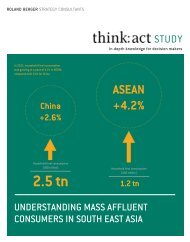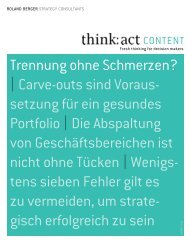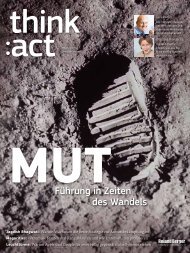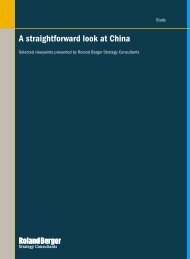Chinese Consumer Report 2012 - Luxury - Roland Berger
Chinese Consumer Report 2012 - Luxury - Roland Berger
Chinese Consumer Report 2012 - Luxury - Roland Berger
Create successful ePaper yourself
Turn your PDF publications into a flip-book with our unique Google optimized e-Paper software.
<strong>Luxury</strong> market capacity in different tier cities<br />
<strong>Luxury</strong> market penetration and average spending in<br />
different tier cities<br />
Population [million]<br />
Average spending<br />
[thousand/year]<br />
Penetration of luxury<br />
goods: first-tier, secondtier,<br />
third-tier, fourth-tier<br />
Number of cities<br />
Source: 2011 <strong>Roland</strong> <strong>Berger</strong>’s <strong>Chinese</strong> <strong>Luxury</strong> <strong>Consumer</strong>s Survey (n=1,393), industry interviews; <strong>Roland</strong> <strong>Berger</strong> analysis<br />
58 key battlefield cities for <strong>Chinese</strong> luxury brand market<br />
spending power<br />
Battlefield for<br />
luxury goods<br />
consumer spending power<br />
third-tier<br />
Total spending in luxury goods<br />
in different tier cities<br />
[100 million]<br />
fourth-tier<br />
Key battlefield for luxury companies<br />
first-tier<br />
second-tier<br />
Source: 2011 <strong>Roland</strong> <strong>Berger</strong>’s <strong>Chinese</strong> <strong>Luxury</strong> <strong>Consumer</strong>s Survey (n=1,393), China City Statistical Yearbook, National<br />
Development and Reform Commission, Yearbook of China Retail Corporations in Chain; <strong>Roland</strong> <strong>Berger</strong> analysis<br />
#city<br />
Spending on<br />
luxury goods<br />
Population (million)<br />
City <strong>Luxury</strong> brand<br />
population consumers<br />
population<br />
Key battlefield<br />
coverage<br />
#city<br />
City<br />
population<br />
Target<br />
consumer<br />
group of<br />
luxury goods<br />
Spending on<br />
luxury goods<br />
Broaden the core market for marketing<br />
There is untapped potential for sales in China's<br />
luxury goods segment. Although most luxury<br />
companies have opened stores in China's first<br />
and/or second-tier cities, buyers from third<br />
and fourth-tier cities account for nearly 40%<br />
of total sales. This proportion is expected to<br />
further increase in the future.<br />
<strong>Consumer</strong>s from second-tier cities have<br />
contributed a higher percentage of sales than<br />
those from first-tier cities. <strong>Consumer</strong>s from<br />
third and fourth-tier cities together have also<br />
contributed a higher percentage than those in<br />
first-tier cities.<br />
In our view, there are many key battlefield<br />
cities for luxury companies in China. As it<br />
is unrealistic to cover all third and fourthtier<br />
cities, we have identified the key cities<br />
of the luxury market through our proprietary<br />
model, which is based on spending power and<br />
economic scale.<br />
In this model, which follows the 80/20 rule,<br />
we aimed to cover the largest luxury goods<br />
consumer population with the fewest number<br />
of cities. According to our model, 70% of luxury<br />
goods consumers can be reached by covering<br />
58 cities. Leading international brands have<br />
not yet reached this coverage level. In the near<br />
future, the growth of China's luxury market<br />
will still be driven by store expansion from<br />
multinational luxury companies.<br />
Low-tier market coverage by international<br />
luxury goods companies is still low but<br />
considerable market capacity exists for<br />
network growth.<br />
The key question for international luxury brands<br />
is how to effectively reach that large pool of<br />
potential buyers in third and fourth-tier cities.<br />
10















